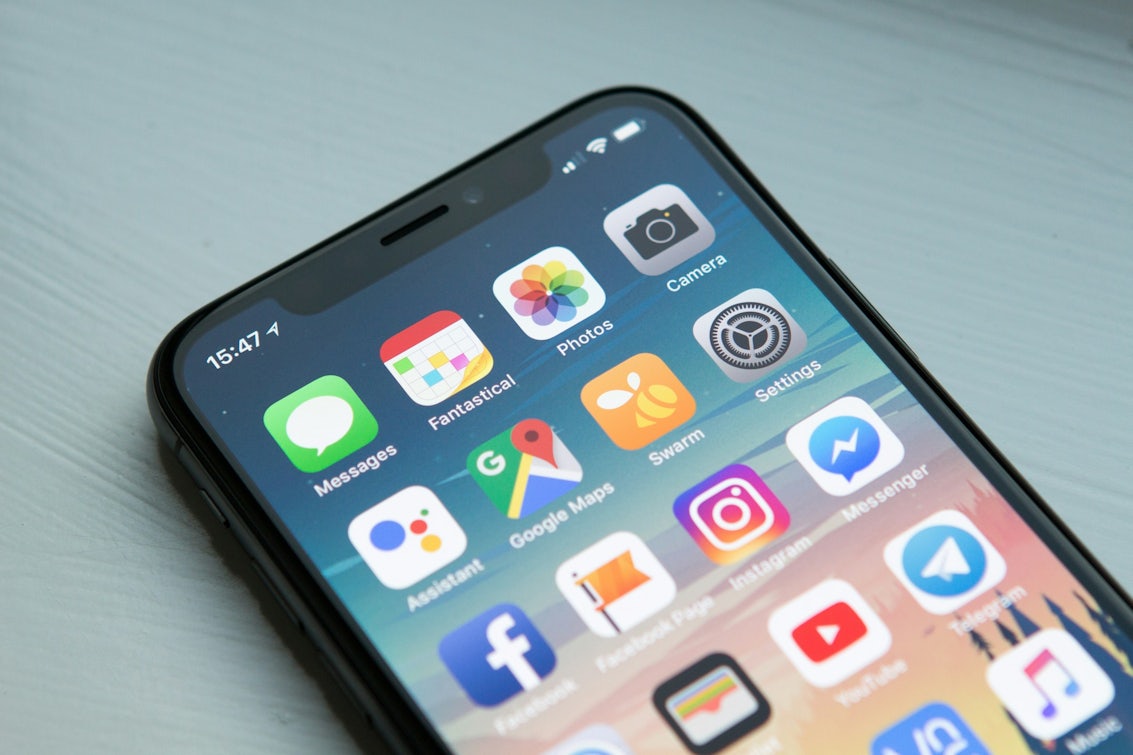Whether you’re loving it or leaning against it, we are very much living in a mobile-first world. Because of this, mobile marketing is now an invaluable channel for businesses. Consumers are now relying predominantly on smartphones and tablets for everything from communication to shopping, meaning that the digital realm is now the primary gateway for brands to connect with and engage consumers through their devices.
Beyond just mobile-friendly websites, mobile marketing allows for real-time, personalised interactions. By using social media and messaging apps such as WhatsApp, you can establish direct lines of communication, enabling you to reach users in real-time on the apps that they frequent daily, with updates, promotions and customer service messages. It’s this immediate access to consumers’ attention that makes mobile marketing so incredibly powerful for driving awareness, conversions, and, when done correctly, loyalty to a brand.
In this guide, you’ll find practical tips and expert insights from Impression’s in-house team to master mobile marketing and achieve business growth. We’ll explore how integrating CRM with mobile efforts unlocks opportunities for personalisation, automation, and customer retention.
Mobile marketing is a broad topic with lots to dive into. If you’re after something specific, use the links below to jump straight to it.
Ready to get started with a mobile marketing agency? For a free consultation, speak to our team today.
- What is mobile marketing?
- Types of mobile marketing
- In-app marketing
- Social media marketing
- Mobile push marketing
- SMS marketing
- QR code marketing
- Location-based marketing
- WhatsApp marketing
- Mobile marketing vs traditional marketing
- How to run a successful mobile marketing campaign
- 1. Set clear objectives for your mobile marketing campaign
- 2. Choose the right mobile channels
- 3. Build and segment your mobile audience
- 4. Personalise your messaging
- 5. Automate your mobile marketing campaigns
- 6. Benchmark against your competitors
- Mobile marketing metrics and how to measure success
- Click-through rate
- Conversion rate
- Cost per acquisition (CPA)
- Engagement rate
- Bounce rate
- Uninstall rate
- Average session duration
- Optimising campaigns for engagement
- Personalising mobile experiences through data
- Running A/B tests on your messaging
- Using multimedia to enhance mobile engagement?
- Enhancing mobile usability
- What's next for mobile marketing?
- WhatsApp messaging
- Augmented reality (AR)
- Multimedia messaging services
- User-generated content (UGC)
- Conversational AI
- How Impression can help with your next mobile marketing campaign

What is mobile marketing?
Mobile marketing is a branch of digital marketing focused on the promotion of products and services through mobile devices, mostly using channels such as social media, apps, SMS, push notifications and email. The beauty of it is that it not only enables brands to connect with users in real-time, but also wherever they are, enhancing both reach and relevance. In turn, this has given marketers the scope to gather more data than ever before, which, of course, has revolutionised the art of personalisation, meaning not only are we able to reach more users than ever before, but we can target them more strategically.
As mobile usage continues to outpace desktop, businesses need to ensure their digital touchpoints are fully optimised for mobile experiences – this includes everything from responsive UI designs to app-based engagement. Anything less than a mobile-first approach will leave brands more and more at risk of becoming inaccessible and disrupting the customer journey.
Mobile marketing also plays into wider digital marketing strategies, particularly when integrated with marketing automation. Automated workflows give us the ability to deliver highly targeted emails, as well as SMS campaigns or push notifications, all based on user behaviour and CRM insights. This is key for targeting the pre-purchase journey and creating effective urgency messaging sent directly to users who are likely to convert based on their actions. It can also help to nurture the post-purchase journey, and build up brand awareness to the point where users are loyal and willing to repurchase.
Types of mobile marketing
The rise of mobile marketing has given way to several more nuanced branches of marketing, from engaging social media campaigns to highly personalised in-app promotions. Each type can contribute uniquely to a brand’s business objectives, whether that’s increasing brand awareness, driving sales or enhancing customer retention. To state the obvious, not every business will have the same traffic through the same channels, so understanding the pros and cons of each allows you to craft a holistic mobile marketing strategy, tailored to specific goals and your target audience demographics.
In-app marketing
If you have a phone, you’re more than likely to be aware of in-app marketing. It centers around delivering promotional messages or content directly within a mobile application. This includes anything from banner ads and sponsored content, to personalised offers triggered by user behaviour within the app. The goal here is pretty simple: Engage users in a highly contextual environment, leveraging their in-app behaviour to deliver highly relevant messages that not only enhance their experience, but also encourage specific actions (namely making a purchase or subscribing to a service).
This method thrives on its ability to reach users when they are most engaged and receptive. For example, food delivery apps use in-app banners to promote a “50% off first order” deal to new users upon their third login, encouraging conversion. This approach minimises disruption while simultaneously maximising relevance, making promotions feel like a natural part of the app experience and tempting users to order.
Example: Just Eat has several promotions being offered across restaurant listings.
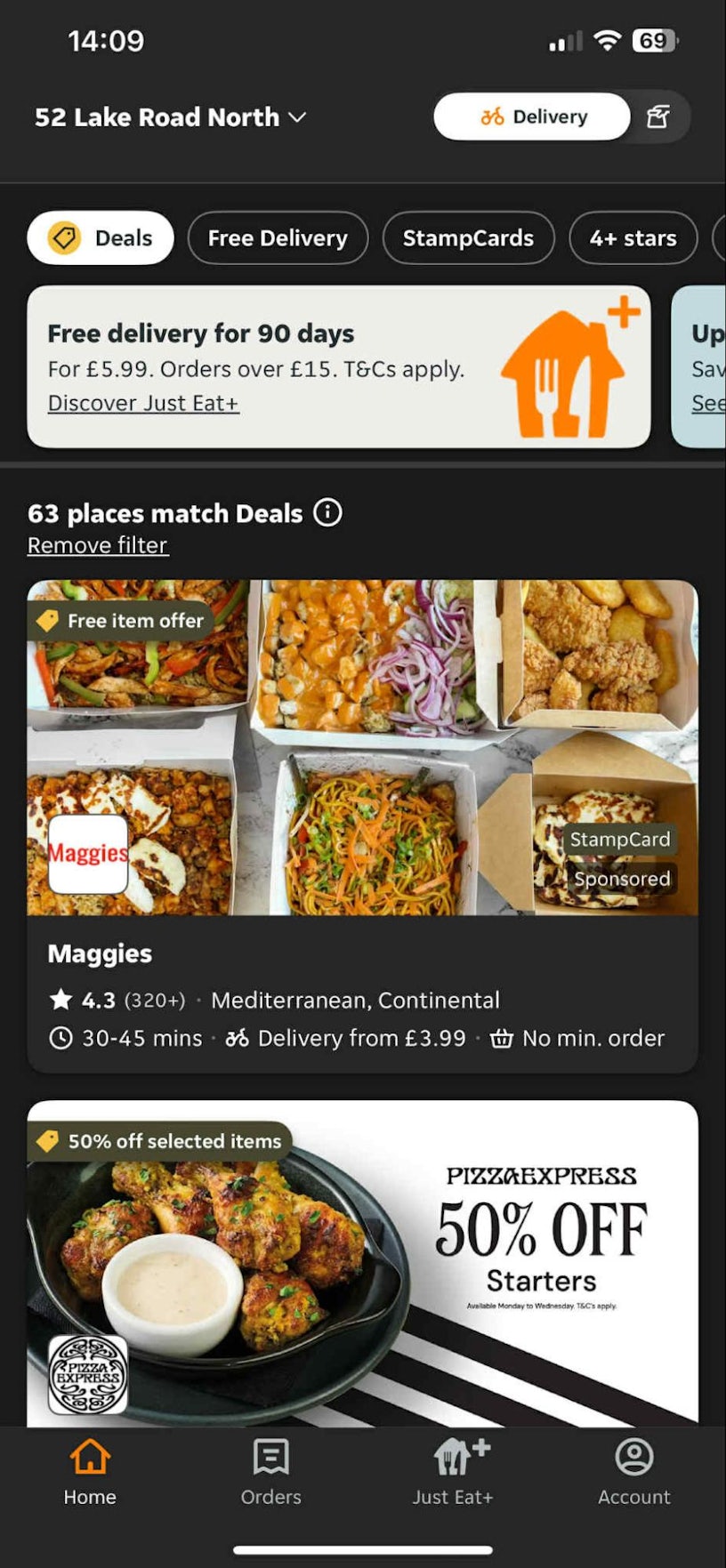
Social media marketing
As the name explains, social media marketing depends on social platforms like Instagram, TikTok, Facebook and X (formerly Twitter) to connect with target audiences. The focus here is to create engaging content designed to be consumed effortlessly on mobile devices, from short-form videos and interactive stories to compelling imagery and written posts. The goal is to build brand awareness, foster community engagement, drive traffic to mobile-optimised sites and ultimately generate leads or sales.
One advantage of social media marketing strategies is that these platforms are mobile-first by design, offering vast reach and sophisticated targeting capabilities. Brands can run highly specific ad campaigns based on easily analysed demographics, audience interests and user behaviours. This level of connection between brand and user has created an opportunity to ensure content always reaches the most relevant users. Interestingly, this type of marketing has now paved the way for user-generated content (UGC) to enter the playing field, which has helped brands build credible trust with their audiences.
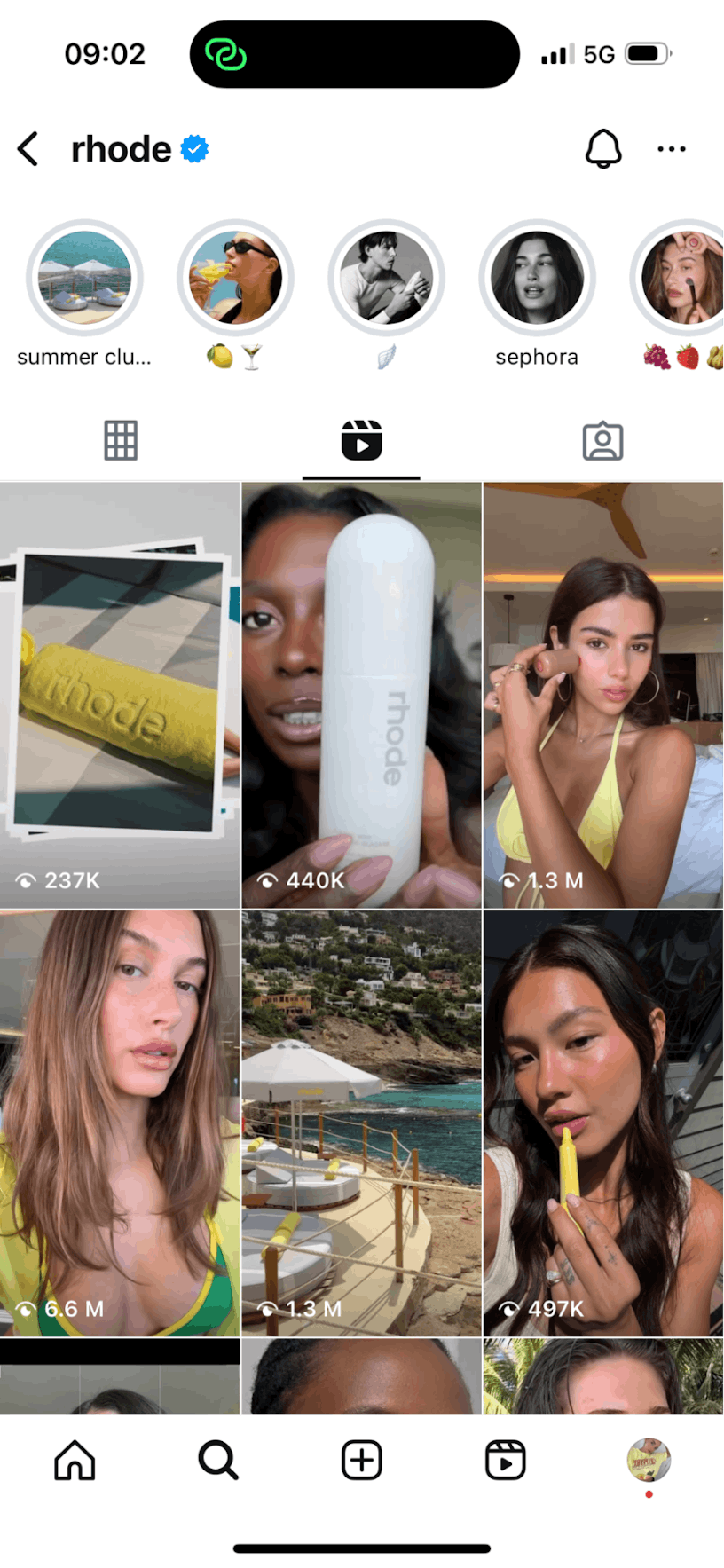
Example: Skincare brand ‘Rhode’ has built a highly engaged audience on social media using a mix of UGC and highly relevant marketing campaigns. UGC content includes consumers using the products or taking pictures of the product in popular locations, with product campaigns taking advantage of social trends and sensory marketing.
Mobile push marketing
Mobile push marketing allows businesses to send direct notifications to a user’s mobile device, even when they are not actively using the associated app. These notifications usually alert users to new promotions and offers, order updates, abandoned cart reminders or re-engagement prompts. The primary objective is to capture immediate attention and drive users back into the app or to a specific action, capitalising on the instant visibility of these messages.
As with emails, there’s a fine line between effectively sending out notifications and spamming your users. The sweet spot comes from refining the strategy to send only timely, relevant and concise notifications to those who have opted in, offering clear value to the recipient. With an ever-growing presence of brands using apps, comes an ever-growing risk of over-saturating users with irrelevant notifications, which can lead to them being switched off or even worse for conversions, the app being deleted. This is why a thoughtful and, more importantly, a tailored strategy is essential. By making use of behavioural data and personalisation, you can easily tailor notifications to encourage users to re-enter the app based on their preferences and habits.

Example: ASOS regularly uses push notifications to alert users of products coming back into stock, promotions, or, in this case, informing them when a saved product has gone down in price. The information is paired with urgency messaging to encourage users to open the app and buy the product at a discounted price, before it sells out.

Example: Deliveroo uses notifications to encourage users to spend money by offering discounts on grocery orders.
SMS marketing
SMS marketing allows businesses to send promotional or informational messages directly to mobile phone numbers, irrespective of having the right app or being followed on social media. The messages you’ve probably seen the most are flash sales announcements, appointment reminders or even delivery notifications. The main goal is to deliver urgent or time-sensitive information directly to the customer, taking advantage of the high open rates of text messages.
SMS marketing is highly effective due to its simplicity and immediate delivery. Almost all mobile phone users can receive SMS, even those without a smartphone or internet connection, making it a powerful tool for broad reach. As with most mobile marketing strategies, there is a risk of spamming users if not done carefully enough (plus an extra, smaller risk that it could cause disappointment to those waiting for an important message, only to open a message about discounted pizzas).
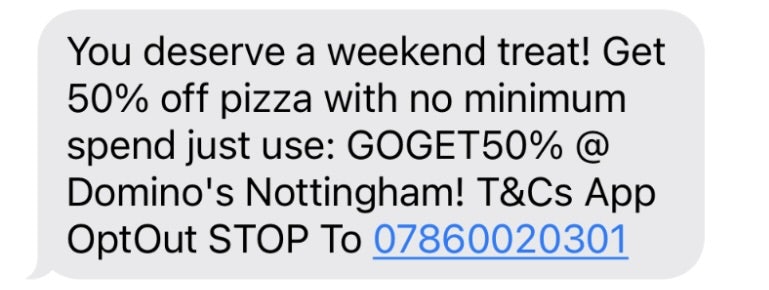
QR code marketing
Placed on physical materials like product packaging or posters, QR codes are the portal between physical and digital marketing. Their purpose is to provide instant access to mobile-optimised content or experiences with a simple scan using a smartphone camera. Under the right circumstances, this can be a clever way to increase traffic to webpages and app downloads.
A big advantage of using them is their versatility, supporting a wide range of marketing objectives from lead generation to customer education. They offer a convenient way to engage mobile users by removing the need for manual URL typing, which can often result in lost sales due to mistyped addresses. Additionally, it’s a different way to track offline campaign effectiveness and gather valuable data on user engagement.

Location-based marketing
Location-based marketing targets consumers based on their geographical position, often using GPS data or Wi-Fi signals. This allows businesses to send especially relevant, personalised messaging when a customer is near a physical store or a specific event. The main objective is to drive foot traffic and encourage immediate purchases, or offer hyper-localised information.
This strategy capitalises on real-time proximity to create highly contextual engagement opportunities, as well as knowing that most of us always have our phones in our hands. For example, a coffee shop could send a discount code to users who enter a specific radius around their store. It’s an effective way to convert online interest into offline action by providing timely, location-specific incentives. (on a related note, check out our guide to Local SEO!)
WhatsApp marketing
WhatsApp – the messaging platform where you’re probably in at least 10 different groups, and now also seeing notifications come through from businesses or even celebrities. The premise of this marketing strategy is to communicate directly with customers, nurturing the idea of being part of a community. Brands can send promotional messages, customer service updates or interactive content. Its strength lies in its ability to facilitate real-time, personal conversations in a trusted and widely used environment. There is also the option to create an online community, which, to many people, can feel less intrusive than SMS messaging, whilst also building brand awareness and trust.
Brands can manage conversations at scale, automate responses and send rich media messages. Furthermore, WhatsApp advertising gives brands the chance to create personalised campaigns and further foster customer loyalty.
Example: Dua Lipa uses WhatsApp marketing to promote new album releases, as well as limited edition copies of vinyl. This method of marketing is very personal and makes users feel as though they are having a direct conversation with her. This can make consumers more likely to convert.
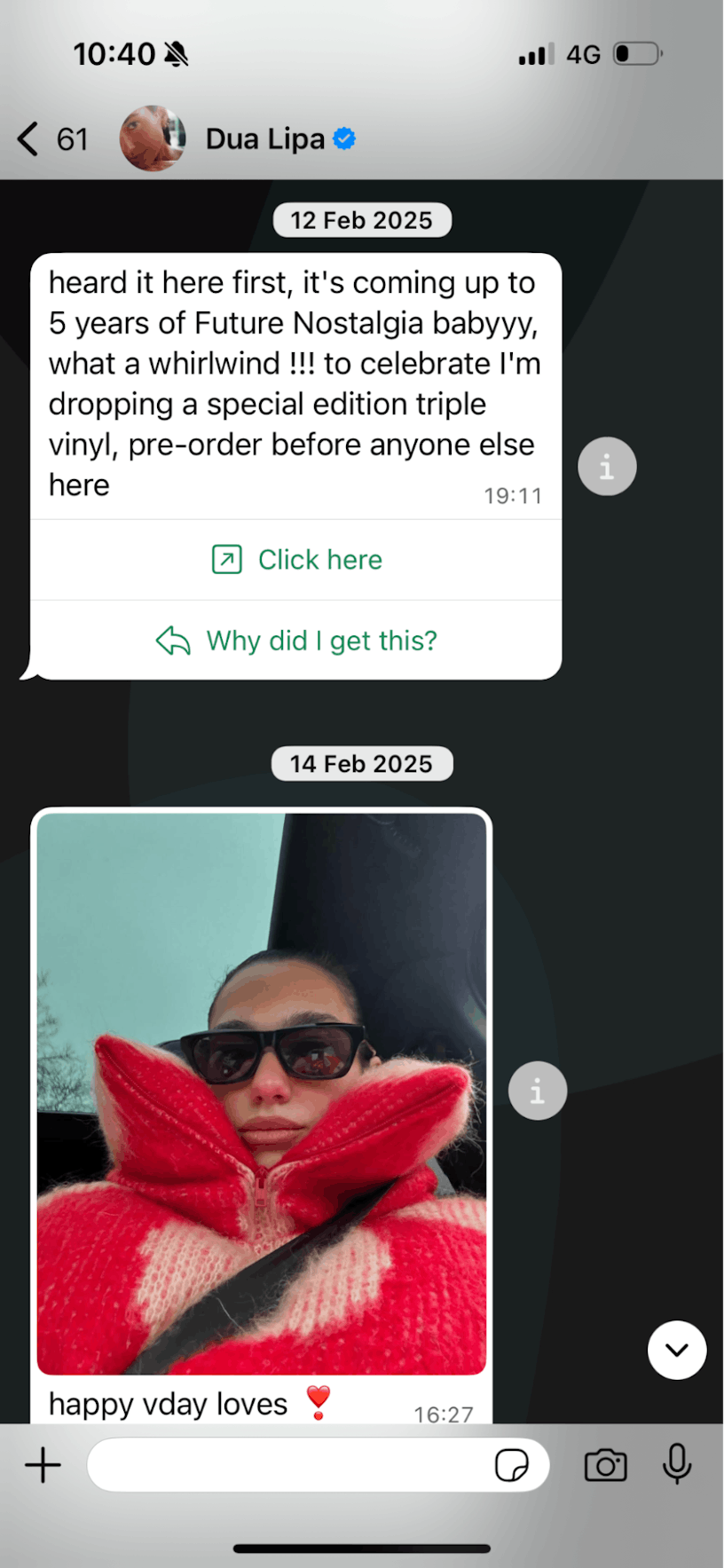
Mobile marketing vs traditional marketing
Mobile marketing massively differs from traditional marketing in its approach to audience engagement and interaction. While traditional methods like print ads, television adverts and radio spots can be tactical, they typically involve one-way communication. Mobile marketing thrives on real-time, two-way interactions, allowing for immediate feedback and a more personal connection with the consumer. The key distinctions though, really lie in audience targeting; mobile marketing can precisely pinpoint users based on demographics, behaviour and even live location – a level of personalisation that, up until now, businesses have struggled to achieve with traditional campaigns.
Another thing to note is that between the two, you’ll find that timing and engagement levels vary significantly. Traditional marketing usually operates on a scheduled basis, for example, TV ads being shown at pre-determined, specific times of day. In contrast, mobile marketing runs on the always-on nature of mobile devices, enhancing interactions and engagement in specific contexts. This immediacy leads to higher engagement rates and more opportunities for conversion, as messages can be highly personalised and delivered precisely when they are most relevant to the individual use (i.e. not just when you’re waiting for an ad break to be over whilst binge-watching that new series).
How to run a successful mobile marketing campaign
Running a successful mobile marketing campaign requires strategic planning and execution across several key areas. From setting clear, measurable objectives to choosing the most effective channels, building a targeted audience, and personalising messages, each step contributes to maximising impact. Automation and competitive benchmarking further refine your approach, ensuring your campaigns are not only efficient but also competitive and continuously optimised for success.
1. Set clear objectives for your mobile marketing campaign
Establishing clear goals and objectives is fundamental for any successful mobile marketing strategy. These objectives will guide your choice of channels, messaging and metrics for success. Goals can vary widely depending on the specific mobile channel you’re utilising; for example, you might aim for high app engagement, increased click-through rates on WhatsApp messages or improved conversion rates from SMS offers. Having clear, achievable objectives will help make sure that your efforts are focused and measurable.

2. Choose the right mobile channels
Selecting the right mobile marketing channels is crucial, as different channels excel at achieving different objectives and resonate with varying customer behaviours. As explained above, your options include direct methods like SMS and push notifications for urgent communications, engaging platforms such as in-app ads and social media for brand building and interaction, and highly personal channels like messaging apps, notably WhatsApp, for community building and personalised offers. This is where understanding your audience really comes into play, as this combined with your campaign goals will dictate the most effective mix of channels.
3. Build and segment your mobile audience
Growing and managing your mobile marketing audience is absolutely essential, and can be easily achieved through clear opt-in processes for SMS or email lists, or via app downloads. Once your audience is established, effective segmentation becomes vital. By dividing your audience based on demographics, past behaviour, interests, or location (to name a few), you can deliver highly targeted and relevant messages. This precision targeting significantly improves campaign performance, enhances user experience and boosts engagement, all while building brand loyalty and increasing CLV.
4. Personalise your messaging
Personalisation is a powerful tool for significantly boosting user engagement in mobile marketing, working most effectively off the back of segmentation. By gathering customer data, such as purchase history, browsing behaviour or past interactions, you can deliver content that feels uniquely tailored to each individual. What’s great is that this can be applied across multiple mobile touchpoints, from customised in-app notifications and personalised SMS offers to dynamic content in social media ads, making messages more relevant and compelling.
5. Automate your mobile marketing campaigns
Marketing automation tools play a key role in supporting and scaling mobile campaigns, streamlining everything from scheduled emails to triggered in-app messaging. Most platforms enable you to set up automated workflows based on user behaviours or pre-defined criteria, ensuring timely and consistent communication without manual intervention. Popular platforms can manage complex customer journeys across various mobile channels, enhancing efficiency and improving the overall customer experience.

6. Benchmark against your competitors
Analysing competitors’ mobile marketing strategies provides valuable insights and helps refine your own approach. Dissect and study their app messaging, social media presence, SMS activity and overall mobile engagement tactics. Not only will this help you see how you compare to their digital presence, but it’ll help you understand what works well and what doesn’t for your specific industry and audience. Tools and methods, such as competitive analysis platforms or direct observation, can offer a deeper understanding of their timing, messaging styles and channel usage. Ultimately, this will help you identify gaps, opportunities and best practices, ensuring your campaigns remain competitive and effective.
Mobile marketing metrics and how to measure success
Tracking the performance of your mobile marketing campaigns is crucial for understanding their effectiveness and optimising future strategies. By monitoring key metrics, you gain invaluable insights into user behaviour, campaign reach and return on investment. These metrics, which can be tracked through various analytics platforms, provide a quantitative measure of success, allowing for data-driven adjustments to your strategy. If data and numbers seems daunting to you, don’t worry, you’re definitely not alone. Our expertise in media solutions and analytics can help you effectively measure and interpret these crucial performance indicators, allowing you to make data-driven decisions without any of the data-disarray!
Click-through rate
Click-through rate (CTR) measures the percentage of users who clicked on a specific link or call-to-action within a mobile marketing message (e.g. SMS, push notification, in-app ad) after viewing it. It’s calculated by dividing the number of clicks by the number of impressions, then multiplying by 100. A high CTR indicates that your message content is engaging and relevant to your audience, prompting them to take further action. Analysing CTR across different campaigns and channels can help optimise messaging, visuals and targeting for improved performance.
Conversion rate
Conversion rate indicates the percentage of users who complete a desired action after interacting with your mobile marketing campaign, such as making a purchase, signing up for a newsletter or downloading an app. It’s calculated by dividing the number of conversions by the total number of interactions (e.g., clicks or views), then multiplying by 100. A strong conversion rate signifies that your campaign effectively guides users towards valuable outcomes for your business, highlighting the effectiveness of your calls-to-action and landing experiences.

Cost per acquisition (CPA)
Cost per acquisition (CPA) measures the total cost incurred to acquire one new customer or lead through your mobile marketing efforts. It’s calculated by dividing the total cost of a campaign by the number of acquisitions generated. A lower CPA indicates a more efficient and cost-effective mobile marketing strategy. Monitoring CPA is particularly useful in helping you allocate budgets wisely, identifying the most profitable channels and optimising campaigns to reduce acquisition costs, all while maximising ROI.
Engagement rate
Engagement rate measures the level of interaction users have with your mobile content or app. This isn’t limited just to clicks, it also encompasses actions such as likes, shares, comments on social media, time spent in an app or specific in-app actions. How you calculate it will depend on the platform and specific engagement type, but it usually follows the format of often total interactions divided by reach or impressions. A high engagement rate suggests that your content resonates with your audience, fostering a strong connection and increasing brand loyalty. This tends to be a common goal for most social media strategies.
Bounce rate
Bounce rate, in a mobile context, typically refers to the percentage of users who visit a single page or screen on a mobile website or app and then leave without interacting further. It’s calculated by dividing the number of single-page sessions by the total number of sessions. A high bounce rate might indicate issues with mobile usability, irrelevant content, slow loading times, or a mismatch between the ad and the landing experience. A/B testing can be a particularly useful solution here for optimising websites for mobile. Streamlining the digital journey and increasing the relevance of your content will help to reduce your bounce rates.
Uninstall rate
Uninstall rates measure the percentage of users who remove your mobile application from their device within a specific period after installation. It’s calculated by dividing the number of uninstalls by the total number of active installations, then multiplying by 100. A high uninstall rate suggests issues with user experience, app value or ongoing mobile app marketing efforts. Tracking this metric as part of your mobile app analytics can be key for identifying some of the problems that lead to user churn. It’ll also provide insights for improving app retention through continuous optimisation.

Average session duration
Average session duration measures the average amount of time users spend interacting with your mobile app or mobile website during a single session. It is calculated by dividing the total duration of all sessions by the total number of sessions. Longer average sessions generally indicate that users find your content engaging and valuable, and/or that your app/site is easy to navigate, providing a rich user experience. Having a good grasp of this metric will allow you to understand your website performance from your customers point of view by asking questions such as: is the content engaging enough to make them want to stay on for longer?
Optimising campaigns for engagement
Measuring the success of your mobile marketing campaigns through data is not just about reporting numbers; it’s an essential tool for boosting engagement and refining your strategy. By thoroughly analysing performance metrics, you can gain actionable insights into what resonates with your audience and what falls short. To achieve continuous optimisation, a data-driven approach should be the backbone of any and all campaigns, allowing you to transform raw figures into strategic adjustments that enhance user interaction and drive more meaningful connections.
Personalising mobile experiences through data
Personalisation should be integrated into all your mobile marketing strategies to ensure you’re creating nothing but highly effective and engaging user experiences. By leveraging comprehensive customer data (anything from browsing history, purchase patterns, demographic information and individual preferences), you have so much opportunity to craft tailored content and offers. As far as data-driven strategies are concerned, this approach is particularly useful for ensuring that mobile messages, whether that be notifications or social media ads, are relevant and timely, significantly increasing the likelihood of user engagement and satisfaction.

Running A/B tests on your messaging
A/B testing allows us to measure how well different marketing messages perform against each other, through experimentation and statistical analysis. In mobile marketing, this means testing different variations of your SMS messages, push notifications, or in-app creative to determine which tactics resonate most with your audience. By systematically testing variables like headlines, calls-to-action, imagery and timing, you can refine your messaging for optimal user engagement and conversion rates.
“Deciding which messaging, design, CTAs and to use in mobile marketing can be really difficult, particularly when multiple stakeholders and teams are involved and when mobile devices are the majority of traffic and conversions. By experimenting, we remove the risk to revenue, and use data to make decisions with confidence”
Michael Weir, Head of Behavioural Science at Impression
Using multimedia to enhance mobile engagement
Incorporating a diverse mix of multimedia elements into your mobile campaigns can significantly impact interaction and engagement. Rich media, such as high-quality images, compelling videos and interactive features like polls or quizzes, captures attention more effectively than plain text. These visual and interactive components enhance the user experience, make messages more memorable and encourage deeper engagement which, in turn, can lead to increased click-throughs, shares and overall campaign performance. As always, there’s no one-size-fits-all approach to multimedia elements, so experimenting to see what your audience engage with the most is vital.
Enhancing mobile usability
Mobile optimisation plays a crucial role in ensuring users can easily and seamlessly engage with your brand on their mobile devices. This involves designing responsive websites, intuitive app interfaces and clear navigation paths that are still effortless for customers to use, even on smaller screens. A fully-optimised mobile experience minimises friction, improves loading times and, most importantly, ensures content is accessible, all of which directly contribute to enhanced performance, boosted conversions and higher customer satisfaction.
What’s next for mobile marketing?
Our understanding of what mobile marketing is and what it is capable of achieving is continuously evolving, mostly thanks to continuously rapid advancements in technology as well as ever-shifting consumer behaviours. There are several emerging trends and technologies that are already redefining how brands connect with their audiences on mobile devices. From more immersive experiences powered by augmented reality, to highly personalised interactions facilitated by conversational AI, these innovations are shaping the future of mobile engagement and present exciting new opportunities for businesses to connect and convert.
WhatsApp messaging
WhatsApp messaging is rapidly becoming a more and more utilised tool in mobile marketing strategies, enabling brands to engage with customers in a more personalised and immediate way. Beyond simple notifications, it allows for two-way communication, without the noise of a social media app, providing real-time customer support, sending tailored product recommendations and delivering interactive content. This direct and trusted channel builds deeper customer relationships and enhances the overall customer experience, making it a key player in modern mobile strategies. For businesses looking to expand their reach on this platform, exploring WhatsApp advertising offers a significant advantage.
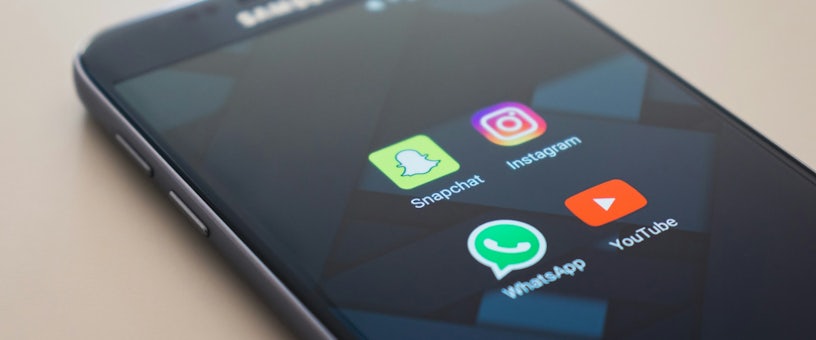
Augmented reality (AR)
Augmented reality (AR) is changing mobile marketing as we know it by offering immersive and interactive brand experiences. The future of AR in mobile includes services you may have already seen, such as virtual try-ons for fashion and beauty products, allowing customers to visualise items before purchase. In this context, immersive shopping experiences can transform how consumers browse and interact with products directly through their smartphone cameras, bridging the digital world and physical products.
Multimedia messaging services
Multimedia messaging services (MMS) are evolving beyond simple image sharing to deliver even more immersive and engaging customer experiences. Modern MMS capabilities allow for richer content, including high-resolution images, short videos and animated GIFs, directly within text messages. With effective media planning and strategising, this format of communication captures attention more effectively, enabling you to convey more complex messages or showcase products in a dynamic and creative way, significantly boosting interaction and engagement within mobile campaigns, because let’s face it, who can resist a good GIF?
User-generated content (UGC)
User-generated content (UGC) is increasingly valuable in digital marketing strategies, particularly in the mobile sphere. The rise of short-form video platforms like TikTok and Instagram Reels has amplified the importance of authentic customer interactions. Brands are leveraging UGC more than ever, from product reviews and unboxing videos to social media posts, to build trust and credibility. In fact, many brands are ditching the high production value ads and using UGC in their place. This authentic content resonates strongly with mobile users, offering genuine testimonials that often outperform traditional brand-created advertising in terms of engagement and influence.
Conversational AI
Conversational AI is becoming a popular choice to enhance customer acquisition and retention in mobile marketing. New features such as intelligent chatbots and automated customer support systems provide instant, personalised assistance around the clock. These AI-powered tools can handle routine queries, guide users through purchase funnels and offer tailored recommendations, which, when done correctly, can improve the customer experience and streamle interactions on mobile devices, ultimately leading to higher satisfaction and conversion rates.
How Impression can help with your next mobile marketing campaign
In this article, we’ve explored how to set your brand up for success with mobile marketing, covering how to plan and optimise your campaigns efficiently, and how to track performance using key metrics. Impression offers a specialist mobile marketing service to help you to elevate your campaigns while driving great results. To find out what we can do for your business, speak to our team today.

